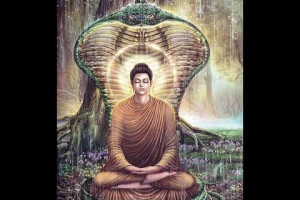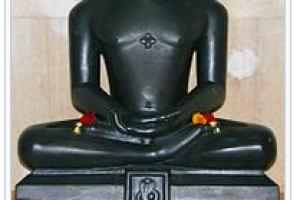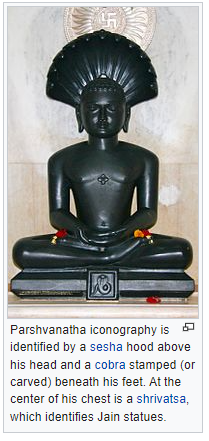Great Beings Series-1: Previous lives of Parshvanatha
October 20, 2022
Houston, Texas
While I was researching a different topic, I landed on this Wikipedia page on Parshvanatha.
Parshvanatha (Pārśvanātha), also known as Parshva (Pārśva) and Parasnath, was the 23rd of 24 Tirthankaras (ford-makers or propagators of dharma) of Jainism.
Jainism is a few centuries older than Buddhism and they were contemporary religions back in the day, lot of similarities but also have certain inherent differences too. Buddhism flourished outside India, but Jainism has been very localized within the India and today reduced to very few places, so many would not have heard about it in modern times
Till the 8th century, Buddhism and Jainism were 2 major religions of India almost 50-50, today both have been sidelined in India. Adi Shankara's arrival and his meager 30 years stay and the energy he left on Indian soil was the turning point in modern Indian history. Also, other exalted beings played roles throughout India in this transformation during 6-8 the century.
-----------------------------------------------------------------------------------------------------------------------------------------
Jain mythology contains legends about Parshvanatha's human and animal rebirths and the maturing of his soul towards inner harmony in a manner similar to legends found in other Indian religions. His rebirths include:
- Marubhuti – Vishwabhuti, King Aravinda's prime minister, had two sons; the elder one was Kamath and the younger one was Marubhuti (Parshvanatha). Kamath committed adultery with Marubhuti's wife. The king learned about the adultery, and asked Marubhuti how his brother should be punished; Marubhuti suggested forgiveness. Kamath went into a forest, became an ascetic, and acquired demonic powers to take revenge. Marubhuti went to the forest to invite his brother back home, but Kamath killed Marubhuti by crushing him with a stone. Marubhuti was one of Parshvanatha's earlier rebirths.
- Vajraghosha (Thunder), an elephant – He was then reborn as an elephant because of the "violence of the death and distressing thoughts he harbored at the time of his previous death".Vajraghosha lived in the forests of Vindyachal. Kamath was reborn as a serpent.
- King Aravinda, after the death of his minister's son, renounced his throne and led an ascetic life. When an angry Vajraghosha approached Aravinda, the ascetic saw that the elephant was the reborn Marubhuti. Aravinda asked the elephant to give up "sinful acts, remove his demerits from the past, realize that injuring other beings is the greatest sin, and begin practicing the vows". The elephant realized his error, became calm, and bowed at Aravinda's feet. When Vajraghosha went to a river one day to drink, the serpent Kamath bit him. He died peacefully this time, however, without distressing thoughts.
- Sasiprabha – Vajraghosha was reborn as Sashiprabha (Lord of the Moon) in the twelfth heaven, surrounded by abundant pleasures. Sashiprabha, however, did not let the pleasures distract him and continued his ascetic life.
- Agnivega – Sashiprabha died, and was reborn as Prince Agnivega ("strength of fire"). After he became king, he met a sage who told him about the impermanence of all things and the significance of spiritual life. Agnivega realized the importance of religious pursuits, and his worldly life lost its charms. He renounced it to lead an ascetic life, joining the sage's monastic community. Agnivega meditated in the Himalayas, reducing his attachment to the outside world. He was bitten by a snake (the reborn Kamath), but the poison did not disturb his inner peace and he calmly accepted his death.
- Agnivega was reborn as a god with a life of "twenty-two oceans of years", and the serpent went to the sixth hell. The soul of Marubhuti-Vajraghosa-Sasiprabha-Agnivega was reborn as Parshvanatha. He saved serpents from torture and death during that life; the serpent god Dharanendra and the goddess Padmavati protected him, and are part of Parshvanatha's iconography.
Taken from the Wikipedia page on Parshvanatha
---------------------------------------------------------------------------------------------------------------------------------------
While I read about his past life, I found it very interesting and revealing. I wanted to share it here.
3 interesting learnings from the reading are:
- Parshvanatha lived during 872-772 BC, much before Buddha and they have a lot of parallels with Shakyamuni Buddha.
- It reminds me of several similarities. Like when Buddha was protected by the Mucalinda serpent from rain, the same way serpent god Dharanendra held a canopy of thousand hoods over Parshvanatha's head and the goddess Padmavati (yakshi, different from Lakshmi Goddess) coiled herself around his body to protect him from a storm
- From the several insignias and incidents, I guess Parshvanatha could be one of the Vishnus or Paramatma, if not a very very high class of empowered Jivatama.
- Some interesting learning was how the thoughts at the end of life could lead to the next birth as mentioned in Bhagavad Gita can be seen here in how Parshvanatha took birth as an elephant
- Also, how several lives enmities played out and one reached higher realms due to good conduct (Parshvanatha) and the other goes to the lowest of realms due to unchanged behavior. Alarming in changing the bad behavior of several lives.






